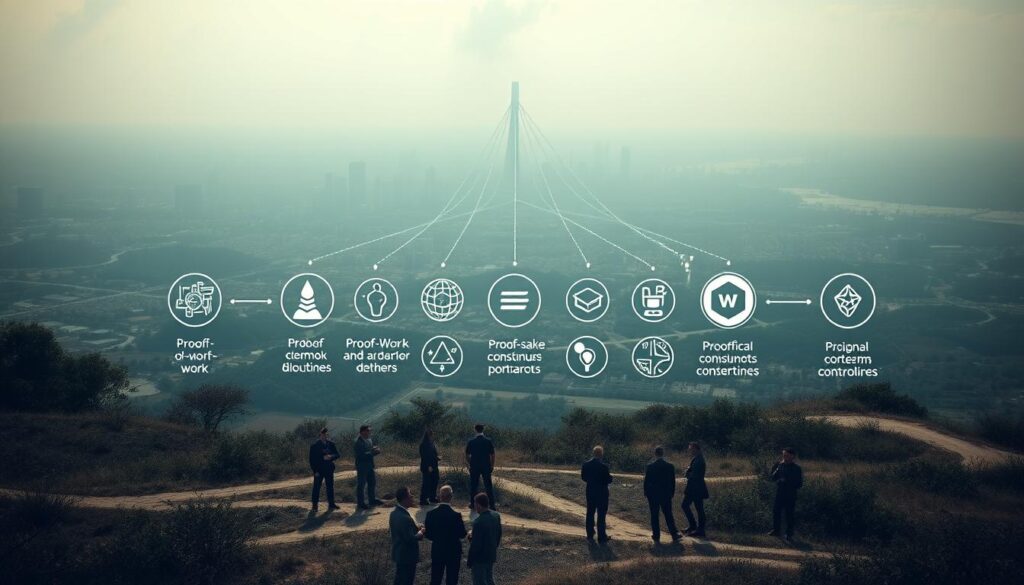Modern decentralized systems rely on specialized protocols to maintain trust among participants. These protocols act as rulebooks for validating transactions and preventing fraud. Their design directly impacts how quickly networks process data, how much energy they consume, and how resistant they become to attacks.
At their core, these systems enable groups to agree on shared records without middlemen. Security remains paramount – bad actors must face significant barriers when attempting to alter verified information. Popular validation methods like proof-of-work and proof-of-stake take different approaches to balance speed with protection.
Energy usage has become a critical discussion point for network operators. Some newer approaches combine elements from existing models to reduce environmental impact while maintaining reliability. Decision-makers must weigh factors like hardware requirements and participation thresholds when choosing solutions.
Key Takeaways
- Validation protocols form the backbone of trust in decentralized record-keeping systems
- Security and energy efficiency often involve trade-offs in network design
- Hybrid models combine multiple approaches to address specific operational challenges
- Participation requirements significantly impact network accessibility and control
- Real-world adoption depends on balancing speed, costs, and security needs
Introduction to Blockchain Consensus Algorithms
Trustless systems depend on predefined rules to synchronize data across all users. These protocols, known as consensus algorithms, allow networks of computers to agree on transaction validity without central oversight. Each participant (node) maintains an identical ledger copy, creating a unified record resistant to tampering.
Byzantine fault tolerance lies at the heart of these systems. This concept addresses how networks reach agreement even when some nodes malfunction or act maliciously. Modern implementations build on decades of research into distributed computing, adapting traditional models for digital asset management.
Effective validation methods balance three critical factors: security against attacks, processing speed, and fair access. Early systems prioritized robustness over efficiency, while newer approaches explore energy-conscious alternatives. The evolution continues as developers seek solutions that scale without compromising decentralization.
Originally developed for military systems in the 1980s, these protocols gained prominence with Bitcoin’s proof-of-work model. Today’s networks use varied methods to prevent double-spending and ensure transactions follow predefined rules. This foundation enables technologies like smart contracts to function reliably across global nodes.
Understanding Blockchain Technology and Its Impact
Shared record-keeping methods are redefining trust in digital interactions across industries. These systems enable organizations and individuals to collaborate on maintaining accurate transaction histories without relying on third-party intermediaries. At their core, this approach combines advanced cryptography with network-wide participation to create tamper-resistant databases.
Decentralization and Security Fundamentals
Distributed networks achieve reliability through collective verification. Each participant maintains identical copies of transaction records, ensuring no single point of failure exists. Cryptographic hashing acts as a digital fingerprint, locking data into immutable blocks once validated.
Transparency and Data Integrity
Every network member can audit transaction histories in real time, creating built-in accountability. Advanced structures like Merkle trees allow efficient verification of large datasets while detecting unauthorized changes. This combination of visibility and protection makes distributed ledger technology particularly valuable for supply chains and financial services.
Three critical features define these systems:
- Network-wide synchronization of records
- Mathematical safeguards against data alteration
- Open verification processes for all participants
Overview of Blockchain Consensus Algorithms
Digital agreement protocols form the backbone of decentralized networks. These systems enable participants to validate transactions through predefined rules. Their design determines how quickly data gets processed and how resources get allocated across the network.

Basic Mechanisms and Terminology
Network validators play distinct roles depending on the protocol. Miners solve complex puzzles in computation-based systems, while stakers lock digital assets as collateral. Finality refers to irreversible transaction confirmation, preventing conflicting updates.
Three core principles guide protocol design:
- Protection against malicious actors
- Efficient handling of growing user bases
- Fair access to validation rights
Early systems prioritized security through energy-intensive processes. Newer models combine stake requirements with randomized checks to reduce environmental impact. Hardware demands and participation barriers often dictate network accessibility.
| Protocol Type | Energy Use | Validation Speed | Entry Requirements |
|---|---|---|---|
| Computation-Based | High | Moderate | Specialized hardware |
| Stake-Based | Low | Fast | Currency ownership |
Hybrid approaches merge multiple validation methods to address specific needs. Developers balance speed against potential vulnerabilities when choosing systems. The right solution depends on a network’s priorities and operational constraints.
Detailed Look at Proof-of-Work (PoW) Algorithm
The digital validation method pioneered by Bitcoin uses competitive puzzle-solving to secure transactions. Miners deploy specialized hardware to hunt for specific numeric values called nonces, which unlock new blocks in the chain. This process ties network security directly to computational effort, creating irreversible records verified by participants worldwide.

Energy Consumption and Performance Challenges
Mining operations consume vast amounts of electricity due to constant hardware activity. Bitcoin’s network alone uses more power annually than some European nations. High energy costs create barriers for new participants, often concentrating control among large mining pools.
Transaction speeds remain limited compared to traditional systems. Networks using this validation method typically process 5-7 transactions per second. Delays increase during peak usage as miners prioritize solving puzzles over rapid confirmations.
| Aspect | PoW Requirement | Operational Impact |
|---|---|---|
| Hardware | ASIC miners | High startup costs |
| Power Use | 90+ TWh/year | Environmental concerns |
| Speed | 10-minute blocks | Throughput limits |
Security Aspects and Decentralization Trade-offs
The system’s security grows stronger as more miners join the network. Attempting to alter past transactions would require controlling over 51% of global mining power – an increasingly impractical feat. This protection comes at the cost of energy demands that challenge long-term sustainability.
While the method prevents centralized control theoretically, real-world mining pools often dominate validation rights. Geographic concentration of mining facilities raises questions about true decentralization. Despite these trade-offs, the approach remains trusted for securing high-value networks.
Examination of Proof-of-Stake (PoS) Consensus
New validation models prioritize resource efficiency while maintaining transaction integrity. Proof-of-Stake (PoS) systems select validators based on their cryptocurrency holdings rather than computational power. This approach eliminates energy-intensive mining, creating greener networks that process transactions faster.

Advantages and Potential Vulnerabilities
Stake-based validation reduces energy consumption by over 99% compared to older methods. Participants lock digital assets as collateral, earning rewards for honest behavior. Lower hardware requirements allow broader participation, fostering more decentralized networks.
Transaction finality accelerates since validators don’t compete to solve puzzles. Most PoS systems confirm payments in seconds rather than minutes. However, large stakeholders could theoretically dominate validation rights, creating centralization risks.
Security mechanisms like slashing conditions penalize malicious actors by destroying their staked tokens. Despite these safeguards, challenges remain. The “nothing at stake” issue allows validators to support multiple transaction histories without financial consequences.
Developers address vulnerabilities through randomized validator selection and stake limits. These measures aim to balance accessibility with protection against wealth-based attacks. As networks evolve, PoS continues reshaping how digital systems achieve agreement securely and sustainably.
Analysis of Delegated Proof-of-Stake (DPoS) Mechanism
Voting-based validation systems introduce democratic decision-making to digital networks. In DPoS setups, stakeholders elect delegates through token-based voting to manage transaction verification. This approach streamlines operations by reducing the number of active validators while maintaining accountability.

Elected delegates handle block creation and network governance, typically numbering between 21-101 depending on the system. This structure enables faster processing times – some DPoS networks confirm transactions in under 1 second. Regular voting cycles let participants replace underperforming validators, creating continuous performance incentives.
Three key advantages define this method:
- Energy efficiency comparable to basic stake-based systems
- Throughput exceeding 5,000 transactions per second
- Built-in governance through delegate accountability
| Protocol | Validators | Speed (TPS) | Decentralization |
|---|---|---|---|
| DPoS | 21-101 elected | 3,000-6,000 | Moderate |
| PoW | Unlimited miners | 5-7 | High |
| PoS | Stake-based | 50-200 | Variable |
While offering speed benefits, the model risks centralization if delegates form cartels. Geographic clustering of validators could expose networks to regional disruptions. Despite these challenges, voting mechanisms provide flexible governance missing in older systems.
Developers often choose DPoS for applications needing rapid settlements and clear governance structures. The balance between efficiency and decentralization continues evolving as networks experiment with delegate rotation systems and anti-collusion measures.
Comparative Analysis of Hybrid Consensus Approaches
Next-generation networks are blending validation techniques to overcome traditional limitations. Hybrid systems merge different agreement protocols, creating tailored solutions for speed, security, and sustainability. This approach allows networks to adapt to changing demands while maintaining core principles of decentralization.
Trade-offs in Scalability and Security
Combining validation methods often delivers better results than single-protocol systems. For example, some networks use proof-of-work for initial security checks and proof-of-stake for faster confirmations. This layered strategy reduces energy use while keeping transaction histories secure.
Three critical benefits emerge in hybrid setups:
- Balanced resource allocation between hardware and token ownership
- Faster transaction finality through staged validation processes
- Improved attack resistance via multiple verification layers
Scalability challenges persist despite these innovations. Networks using mixed protocols typically handle 500-2,000 transactions per second – better than older systems but still lagging behind centralized alternatives. Security audits become more complex as multiple mechanisms interact, requiring advanced monitoring tools.
| Approach | Speed (TPS) | Energy Use | Decentralization |
|---|---|---|---|
| Hybrid | 500-2,000 | Medium | High |
| PoW | 5-7 | Very High | Moderate |
| PoS | 50-200 | Low | Variable |
Real-world implementations show hybrid models excel in regulated industries. Financial institutions benefit from customizable validation rules that meet compliance standards. Public networks gain flexibility to prioritize either speed or security based on user needs.
Blockchain Consensus Algorithms Comparison Analysis
Validation protocols vary widely in their approach to balancing speed and decentralization. These systems shape network performance through unique incentive structures and security measures. Their design choices directly affect how users interact with digital ledgers and what trade-offs they accept.
Core Distinctions in Validation Models
Transaction processing speeds reveal stark contrasts between protocols. Proof-of-Work handles 5-7 transactions per second, while Delegated Proof-of-Stake systems exceed 5,000. Energy demands follow inverse patterns – stake-based methods use 99% less power than computation-heavy alternatives.
Security models diverge significantly. Some rely on hardware investments to deter attacks, others on financial stakes. Hybrid approaches layer multiple safeguards but require complex coordination between validation stages.
| Protocol | Speed (TPS) | Energy Use | Decentralization |
|---|---|---|---|
| Proof-of-Work | 5-7 | Extreme | High |
| Proof-of-Stake | 50-200 | Low | Moderate |
| DPoS | 3,000-6,000 | Low | Limited |
| Hybrid | 500-2,000 | Medium | Variable |
Participation requirements create different network dynamics. Hardware-intensive methods favor specialized operators, while token-based systems empower currency holders. Economic incentives also vary – some reward validators with new tokens, others with transaction fees.
These differences impact real-world adoption. Financial institutions often prefer customizable hybrid models, while public networks prioritize either accessibility or throughput. Understanding these trade-offs helps users select platforms matching their priorities.
Impact of Consensus Mechanisms on Blockchain Scalability
Distributed ledger systems face critical growth limitations based on their validation rules. These protocols govern how quickly networks process transactions while maintaining security. Transaction throughput, block creation speed, and node efficiency all depend on the chosen approach.
- Security requirements that slow verification processes
- Decentralization needs demanding broad participation
- High-volume transaction handling for mass adoption
Layer-2 solutions like payment channels rely on base-layer validation rules. A recent study shows protocols with faster finality times better support these enhancements. Networks using quick confirmation methods enable more efficient off-chain transactions.
Operational demands vary significantly between systems. Some require nodes to store entire transaction histories, while others use compressed data formats. Bandwidth usage and hardware costs often determine participation levels – key factors in maintaining decentralization.
Future improvements must address growing global transaction volumes. Emerging models combine sharding techniques with optimized validation steps. The goal remains clear: enable secure, decentralized networks to process thousands of transactions per second without compromising core principles.
Security Implications of Various Consensus Algorithms
Digital trust systems face distinct security challenges shaped by their validation rules. Each approach creates unique defense patterns against malicious activities. Proof-of-work networks battle 51% attacks where miners gain excessive control, while stake-based systems combat “nothing-at-stake” exploitation attempts.
Cryptographic safeguards differ across protocols. Some rely on energy-intensive computations to verify transactions, others use financial penalties to ensure honest behavior. Attack costs vary dramatically – compromising one system might require billions in hardware, another demands majority ownership of digital assets.
Ongoing research reveals new vulnerabilities as networks scale. Developers now implement slashing mechanisms that destroy misbehaving validators’ stakes and randomize block validation rights. These updates help maintain integrity as transaction volumes grow.
Network architects must balance protection levels with operational practicality. Systems prioritizing speed often face higher risks of coordinated attacks. The safest solutions combine multiple verification layers while allowing protocol adjustments as threats evolve.


No comments yet